The Physics Of Sailing
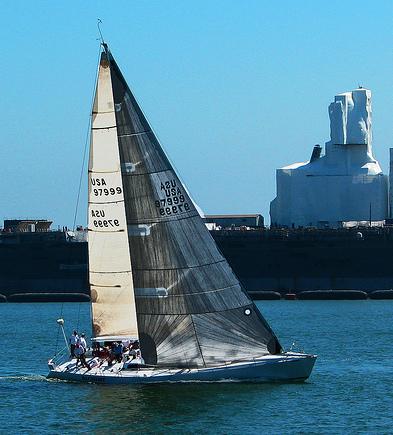
Source: http://www.flickr.com/photos/tomsaint/3371081899
The Physics Of Sailing – Using The Principle Of Lift To Sail Faster
The physics behind sailing is very interesting in that sailboats do not need the wind to push from behind in order to move. The wind can be blowing from the side and the sailboat can still move forward. How is this possible?
The answer lies in the well-known principle of aerodynamic lift. Imagine you are a passenger in a car as it's moving along, and you place your right hand out the window. If you tilt your hand in the clockwise sense your hand will be pushed backwards and up. This is due to the force of the air which has a sideways component and upwards component (therefore your hand is pushed backwards and up).
In a similar fashion, when the wind blows against the sails from the side, this creates a force which has a sideways component and a forward component.
However, we do not want the sailboat to move sideways. We only want it to move forward (as much as possible). This is accomplished with a keel, located underneath the sailboat. The keel provides the counter-force necessary to resist sideways motion of the sailboat, as much as possible.
So in general, there are two main components of a sailboat which enable it to move forward effectively. They are the sail and the keel, as shown below.
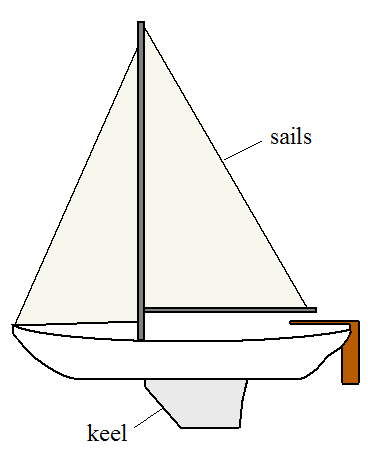
Thus, the physics of sailing involves the interaction of the wind and sails, and the interaction of the water and keel.
Analysis Of Lift
The figure below shows the general case where the wind Vw is blowing at an angle θ from the horizontal. This creates a resultant force on the sails, denoted by Fsails, which points in the direction shown.
Note that Vw is the wind velocity relative to the boat. This is not to be confused with the wind velocity relative to the water. If the boat is moving, these velocities are not the same.
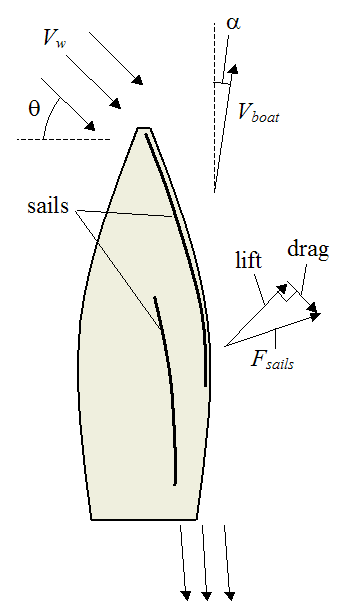
The force Fsails is broken down into two components: lift (which acts perpendicular to the wind direction Vw) and drag (which acts parallel to the wind direction Vw). Lift and drag are defined as acting in these two directions; a convention commonly used in the literature with regards to air flow over a wing. As it turns out, air flow over a sail is very similar to air flow over a wing. The two sails (as shown) are oriented so as to optimize the air flow around and between the sails and generate as much "push" force as possible, to move the sailboat forward. The flexibility of the sails allows them to mimic the behaviour of a wing and be oriented in a variety of different positions to get the most "push", depending on which direction the wind is blowing.
The velocity of the sailboat (relative to the water) is denoted by Vboat. This velocity is in a direction skewed slightly to the right of the center line of the boat, by an angle α. This means that the sailboat does not travel "head on" through the water. It is necessary that the sailboat travel slightly off center (with some sideways movement) because it enables the keel to generate the necessary counter-force to resist the sideways force exerted on the sails by the wind. Consequently, some sideways movement is inevitable, but the keel keeps it (and hence α) as small as possible.
The figure below illustrates how the keel works.
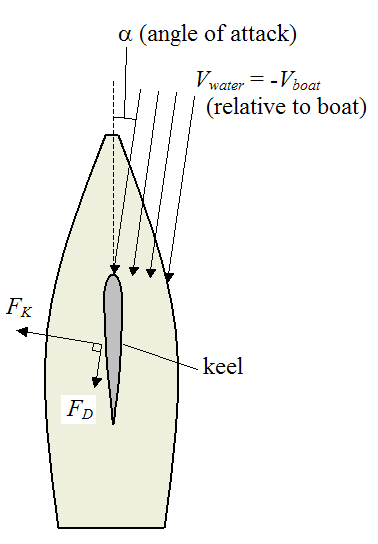
The keel behaves like an underwater wing and the same basic physics applies, as explained above for the sail. The force FK is the force exerted by the water on the keel and hull, due to the angle of attack α the keel makes with the water streamlines. Most of this force is (intentionally) due to the keel, which is large and made to resemble a wing to create as much counter-force as possible in order to minimize sideways movement of the boat. Using the same convention as before, FK is defined as perpendicular to the direction of flow of water Vwater.
The force FD is the drag force exerted by the water on the keel and hull, due to the angle α the keel makes with the water streamlines. Using the same convention as before, FD is defined as parallel to the direction of flow of water Vwater.
We can now sum all the forces acting on the sailboat.
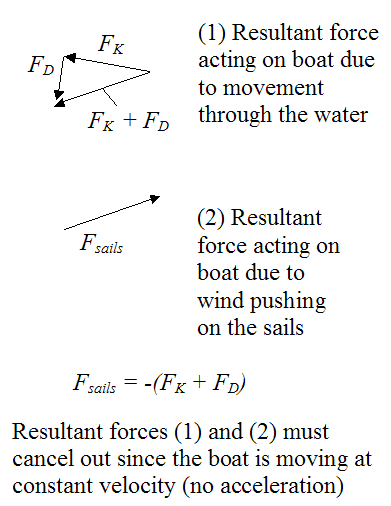
The balance of forces shows that the sailboat is moving at a constant velocity Vboat through the water, due to the forces between wind & sails, and boat & water.
It should be noted that it's impossible for a sailboat to travel directly into the wind (θ = 90° in the above figure). This is because the resultant force Fsails has no forward component. Instead, it has a backward component meaning the sailboat would travel backwards.
So there is an upper limit on how large θ can be. For very efficient sailboats this upper limit is around 60°.
The velocity of the wind relative to the boat (Vw) depends on the speed of the boat (Vboat). One can find Vw using vector addition. If one knows Vboat and the wind velocity relative to the water (call this Vw1), we can use the following vector formula to calculate Vw:
Vw = Vw1 – Vboat
The optimal wind angle for greatest sailboat speed is when Vw is blowing from the side (θ = 0). There are two main reasons for this. The first reason is because the lift force is pointing in the forward direction (parallel to the boat center line). The second reason is because the forward push force (forward component of Fsails) remains fairly constant as Vboat increases. This means that the sailboat can accelerate to a high speed, since the forward push force is largely independent of sailboat speed Vboat.
But if the wind is blowing from behind the boat, Vw (and therefore wind force) is very dependent on Vboat. The faster the boat moves forward, the lower the relative wind velocity Vw and the lower the wind force. For example, if the wind (relative to the water) is blowing at Vw1 = 20 km/h, and the boat is moving at Vboat = 12 km/h (relative to the water), Vw is 20-12 = 8 km/h (relative to the boat). Therefore, the boats speed can never exceed 20 km/h. In fact, the top speed will be significantly less than this.
However, if the wind is blowing from the side it is actually possible for Vboat to be greater than Vw (in magnitude). This is because the push force is great enough and constant enough to propel the sailboat to a high speed.
Tilting Of The Sailboat
A final consideration in the physics of sailing is the tilting of the sailboat which occurs when the wind is blowing from the side. An example of this is shown below.
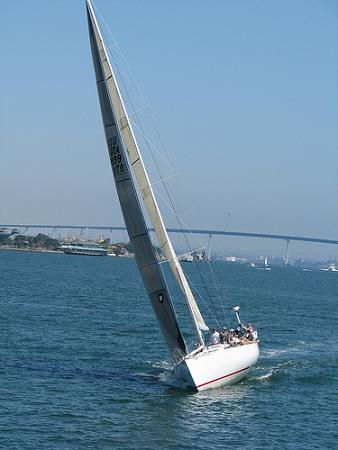
Source: http://www.flickr.com/photos/tomsaint/2706870985
This tilting is due to the torque created by the forces Fsails , FK , and FD. The sideways component of these forces (acting perpendicular to the center line of the boat) creates a clockwise rotation (roll) of the sailboat. This torque is balanced by the counter-clockwise torque generated by the weight of the sailboat and the buoyancy force of the water. The figure below illustrates this.
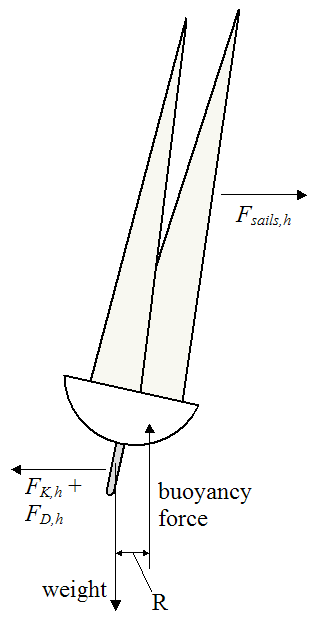
The force Fsails,h is the sideways (horizontal) component of the force Fsails. The forces FK,h and FD,h are the sideways (horizontal) components of the forces FK and FD (respectively). These component forces rotate the sailboat clockwise until the moment arm R becomes large enough so that the weight and buoyancy forces are able to stop the rotation. This results in a strong leaning of the sailboat to the right.
Closing Remarks
By now it should be clear that the physics of sailing is quite complex, having a lot in common with the physics of lift in airplanes.
It is particularly interesting that, with proper orientation of the sails, you can move in almost any direction relative to the wind, using the principles of aerodynamic lift.
Return to The Physics Of Sports page
Return to Real World Physics Problems home page
Free Newsletter
Subscribe to my free newsletter below. In it I explore physics ideas that seem like science fiction but could become reality in the distant future. I develop these ideas with the help of AI. I will send it out a few times a month.